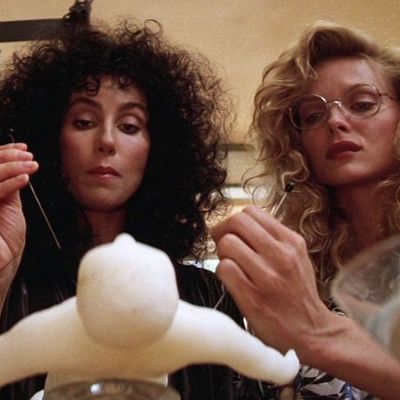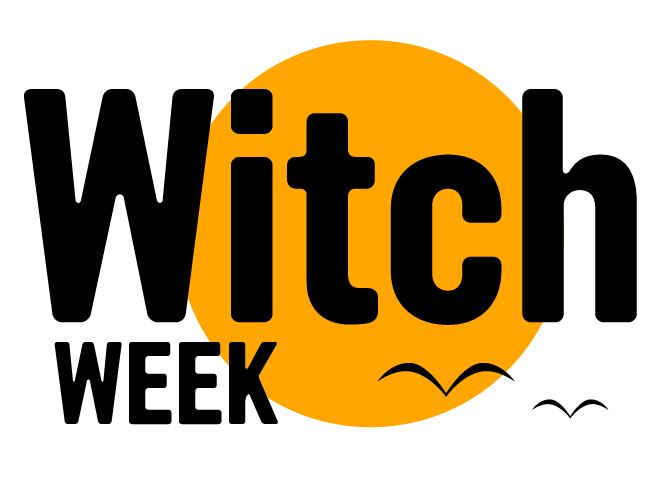
In TV, movies, and real life, women have been at the forefront of the yearÔÇÖs biggest stories ÔÇö so this Halloween season, weÔÇÖre looking at pop cultureÔÇÖs most wicked depiction of female power.
In The Witches of Eastwick, the 1987 film based extremely loosely on the John Updike novel of the same name, the word witch is never uttered. The movie stars three high-profile actresses ÔÇö Cher, Michelle Pfeiffer, and Susan Sarandon ÔÇö who do, eventually, place a hex. But itÔÇÖs Jack Nicholson in the role of the seductive and dangerous Daryl Van Horne, who gets top, first-in-the-opening-titles billing and whose performance ultimately became the dark comedyÔÇÖs primary talking point. ÔÇ£None of them seem a match for Mr. NicholsonÔÇÖs self-proclaimed ÔÇÿhorny little devil,ÔÇÖÔÇØ Janet Maslin wrote in a New York Times review, referring to the three female protagonists. ÔÇ£As battles of the sexes go, this is barely a scrimmage.ÔÇØ In other words, this is a movie with a trio of female leads in which a man somehow still steals focus.
That type of contradictory signaling is what makes The Witches of Eastwick such a thought-provoking movie to consider 30 years after it became a box-office hit, and especially right now, when thereÔÇÖs so much active, public discussion about womenÔÇÖs struggles to assert themselves in a society where men hold most of the power, sexual and otherwise.
(Note: There will be a lot of spoilers ahead about the plot of a 30-year-old movie, if itÔÇÖs possible for the plot of a 30-year-old movie to be spoiled.)
Directed by George Miller in his first full-length departure from the Mad Max franchise, The Witches of Eastwick can be viewed as female empowerment manifesto or as a male gaze-y supernatural story that keeps women in their traditional place. Sometimes it manages to be both of those things in the same scene. The filmÔÇÖs refusal to communicate a singular point of view is, in my view, an issue, though one that doesnÔÇÖt prevent it from being entertaining. But it also speaks to how muddled things can get when people, inside Hollywood and out, wade into the gender-politics pool.
The Witches of Eastwick introduces us to Alexandra (Cher), an artist, widow, and mother to a teenage daughter; Sukie (Pfeiffer), an abandoned single mom and newspaper columnist; and Jane (Sarandon), a divorced, childless classical-music teacher. All of them are accustomed to taking the usual crap from men. In an early scene, JaneÔÇÖs boss puts his hands on JaneÔÇÖs butt and makes an obvious pass at her, then proceeds to makes a speech to the community about how societyÔÇÖs values are ÔÇ£disintegrating.ÔÇØ Alex later refers to him as a Nazi. The more things change, the more they stay the same, am I right?
In UpdikeÔÇÖs novel, the three women are members of an established mini-coven and already have a sense of the evil they can do before they meet Daryl. In the film, though, theyÔÇÖre just overwhelmed ladies who meet once a week to drink martinis, relax, and talk about their unsatisfying sex lives (or lack thereof). The Sanderson sisters of Hocus Pocus would probably find them way dull.
ÔÇ£I donÔÇÖt think men are the answer to everything,ÔÇØ Alex states during one of their Thursday night meet-ups.
ÔÇ£Then why do we always end up talking about them?ÔÇØ Jane responds. The Witches of Eastwick would definitely not pass the Bechdel Test.
Then the wind sweeps Daryl Van Horne into town and he immediately goes to work on seducing all three of them, starting with Alex. Because heÔÇÖs played by Jack Nicholson, Daryl comes across initially as a crass yet impish ladiesÔÇÖ man, the sort that women always go for when they know they shouldnÔÇÖt. But in the harsh light of recent revelations about Harvey Weinstein, among others, his behavior seems alarmingly predatory.
When Daryl invites Alex to his home after expressing interest in her art, he insists they go to his bedroom, where he immediately changes into a robe. (Nicholson is constantly wearing robes in this movie.) He then informs her that ÔÇ£he always likes a little pussy after lunchÔÇØ and suggests they have sex as if, of course, thatÔÇÖs what sheÔÇÖll want to do. (Again, does this sound familiar?)
Alex has no patience for this and launches into what became a Cher signature in the ÔÇÖ80s: the ÔÇ£youÔÇÖre full of shitÔÇØ monologue.
ÔÇ£I am positive that you are the most unattractive man I have ever met in my entire life,ÔÇØ she tells him. ÔÇ£In the short time weÔÇÖve been together, you have demonstrated every loathsome characteristic of the male personality and even discovered a few new ones. You are physically repulsive, intellectually retarded. YouÔÇÖre morally reprehensible, vulgar, insensitive, selfish, stupid. You have no taste, a lousy sense of humor, and you smell. YouÔÇÖre not even interesting enough to make me sick.ÔÇØ (God, I miss Cher in movies. Mamma Mia: Here We Go Again cannot come fast enough, if only for this reason.)
Daryl then oozes his way through a speech that suggests he understands her particular type of female emptiness. Apparently unable to withstand the lure of Satan, she abruptly changes her mind and gives in to him. He later works the same spell on Jane and Sukie, uttering words that suggest he can give them something no other person can. TheyÔÇÖre each eventually so enamored that they donÔÇÖt even mind sharing him sexually, especially once they realize that theyÔÇÖre able to perform magical acts, like levitating tennis balls, thanks to the gifts instilled by his presence. By the time the movie shows them all lounging around DarylÔÇÖs mansion, the womenÔÇÖs hair all wilded out, their bodies draped in lingerie, and their lips sucking cherry after cherry right off the stem, it seems pretty apparent that this is pure male fantasy, right down to the part where the women are only emboldened after landing in a brutish manÔÇÖs orbit. Because itÔÇÖs so over-the-top, though, it also can be viewed as a satire of such fantasies, which makes it hard to take the misogyny inherent in this tableau seriously.
Alex, Sukie, and Jane certainly derive pleasure from the arrangement and continue to honor it of their own volition. They even feel liberated by it. But because Daryl instigated the connection between the four of them, the movie also implies that these women could only be freed with the help of a horny little devil whoÔÇÖs got them on a pretty short leash.
All three of them do, to borrow another great Cher line from another movie, snap out of it. After Daryl channels their collective magic and uses it to cause the death of the most prudish wife in Eastwick, as well as of her husband, the trio shuts him out and he responds by acting increasingly erratically. At that point, the so-called witches take matters into their own hands, finally casting a spell that will get him out of their lives for good.
Ultimately it turns out these women are capable of summoning otherworldly forces on their own, with zero assistance from Daryl. In that sense, The Witches of Eastwick can be viewed as the story of three women who realize they donÔÇÖt need a Daryl ÔÇö or any man, for that matter ÔÇö in their lives. Through that prism, it is a feminist-leaning tale that correctly labels men who try to possess their partners as card-carrying Beelzebubs.
But then along comes the movieÔÇÖs coda, which shows Alex, Sukie, and Jane ÔÇö each of whom got pregnant during their affair with Daryl ÔÇö living together in the luxurious mansion Daryl once owned, while raising the infants he fathered. In the final scene, Daryl suddenly appears on the multiple TV screens in his media room, cooing at the three wee babes, until the women grab the remote and hit the off button.
Again, there are a lot of ways to take this. Yes, the women are erasing Daryl and seem to have the upper hand. But theyÔÇÖve also been reduced to little more than traditional caregivers, forced, albeit seemingly happily, to raise his kids, all of whom happen to be boys. Did Daryl just use them as vessels to put more devils on this Earth? If he did, then maybe Witches of Eastwick is actually a cautionary tale warning women that, in the long run, no matter what they do, they are ultimately powerless. Or, as the mothers of those boys, do the women actually have control over shaping the devilÔÇÖs offspring, implying there is some hope for future generations? The movie feels like itÔÇÖs trying to tell us something, but it holds its tongue so firmly in its cheek that itÔÇÖs hard to grasp exactly what itÔÇÖs saying.
ItÔÇÖs only clear that delving into gender issues is tricky and complicated and open to wide interpretation, which explains why The Witches of Eastwick has continued to be of interest for so many years. In addition to this film, UpdikeÔÇÖs original novel has yielded a sequel in book form, a musical, and three separate failed TV shows, only one of which got past the pilot stage. (ABCÔÇÖs Eastwick, starring Rebecca Romijn, lasted for less than a season in 2009 before it got cancelled.)┬áThe issues that it addresses, in all of its incarnations, are always burning and bubbling beneath the surface of everything.
In a 1984 review of UpdikeÔÇÖs book, also published in the New York Times, Margaret Atwood wrote, ÔÇ£Much of The Witches of Eastwick┬áis satire, some of it literary playfulness and some plain bitchery. It could be that any attempt to analyze further would be like taking an elephant gun to a puff pastry: An Updike should not mean but be.ÔÇØ She adds, however, ÔÇ£But again, I donÔÇÖt think so. What a culture has to say about witchcraft, whether in jest or in earnest, has a lot to do with its views of sexuality and power, and especially with the apportioning of powers between the sexes.ÔÇØ
The movie is not of a single mind in its views of sexuality and power. As for witchcraft, it only allows ÔÇ£witchesÔÇØ to practice their craft when they need to get rid of a man they should have spirited away the minute he slipped on one of his silky robes. Whether it was intended to or not, itÔÇÖs also a movie that illustrates that, for various reasons, even smart, strong women sometimes canÔÇÖt immediately summon the hocus pocus they want or need to make a guy like that disappear. Which is sad, but also true. Of all the many takeaways that come from watching The Witches of Eastwick at this moment in 2017, that may be the one that resonates the most.



